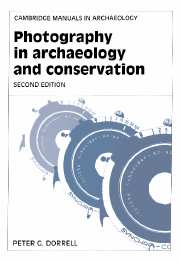Book contents
- Frontmatter
- Contents
- List of illustrations
- Preface
- Preface to the second edition
- Acknowledgements
- 1 The early days of archaeological photography
- 2 Basic principles and practice
- 3 Equipment
- 4 Lighting by flash
- 5 Photographic materials, processing and printing
- 6 Architecture and standing monuments
- 7 Survey photography
- 8 Site photography
- 9 Principles of object photography
- 10 Principles of close-up photography
- 11 Ultra-violet and infra-red photography
- 12 Photographing finds
- 13 Flat copy
- 14 Preparation of material for publication
- 15 The future
- References
- Index
14 - Preparation of material for publication
Published online by Cambridge University Press: 23 December 2009
- Frontmatter
- Contents
- List of illustrations
- Preface
- Preface to the second edition
- Acknowledgements
- 1 The early days of archaeological photography
- 2 Basic principles and practice
- 3 Equipment
- 4 Lighting by flash
- 5 Photographic materials, processing and printing
- 6 Architecture and standing monuments
- 7 Survey photography
- 8 Site photography
- 9 Principles of object photography
- 10 Principles of close-up photography
- 11 Ultra-violet and infra-red photography
- 12 Photographing finds
- 13 Flat copy
- 14 Preparation of material for publication
- 15 The future
- References
- Index
Summary
The end result of all excavations and surveys is – or should be – publication, whether as a monograph, article, microfiche or on disc. Similarly, although the prime objective of conservation is the conserved and stable artifact, publication of results and methods should never be neglected. Unfortunately it is even more difficult to raise money to publish a site than it is to obtain the funds to dig it (and, it must be confessed, working on publication is commonly much less interesting and enjoyable than digging). In addition, the involvement of more and more scientific disciplines in the analysis and elucidation of sites and artifacts makes the tasks of editorship and coordination of reports more demanding.
All this is very well known to anyone working in the field, and certain guidelines on publication have been laid down (Council for British Archaeology (1991)). At the same time as the demands of adequate publication have become more exacting, the costs of printing, blockmaking and binding have risen until conventional hardback publication has become out of the question for most sites. The gap has been filled to some extent by the advent of such techniques as computer typesetting, small-scale litho printing and desk-top publishing, and through the sometimes heroic cost-cutting efforts of learned journals and such concerns as British Archaeological Reports. However laudable the attempt to maintain the flow of publication, one effect has been that the standard of reproduction of photographs, and to a lesser extent of line drawings, has fallen.
- Type
- Chapter
- Information
- Photography in Archaeology and Conservation , pp. 246 - 250Publisher: Cambridge University PressPrint publication year: 1994



